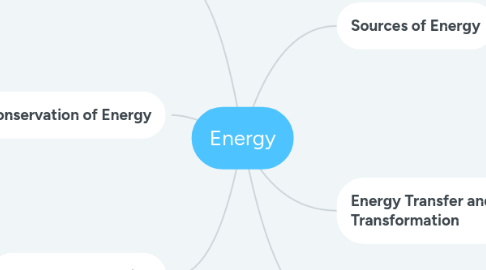
1. Types of Energy
1.1. Kinetic Energy
1.1.1. Examples
1.1.1.1. Moving car
1.1.1.2. Flowing river
1.2. Potential Energy
1.2.1. Examples
1.2.1.1. A stretched spring
1.2.1.2. An object at height
1.3. Thermal Energy
1.3.1. Examples
1.3.1.1. Boiling water
1.3.1.2. Burning candle
2. Conservation of Energy
2.1. Energy Efficiency
2.1.1. Ways to Conserve Energy
2.1.1.1. Energy-saving appliances
2.1.1.2. Home insulation
2.2. Energy Recycling
2.3. Smart Grids
3. Energy Consumption
3.1. Energy Use in Different Sectors
3.1.1. Residential
3.1.2. Commercial
3.1.3. Industrial
3.1.4. Transportation
3.2. Energy Consumption Trends
3.3. Energy Waste
3.3.1. Ways to Minimize Energy Waste
3.3.1.1. Energy audits
3.3.1.2. Implementing energy-saving practices
4. Sources of Energy
4.1. Renewable Energy
4.1.1. Solar Energy
4.1.1.1. Photovoltaic Cells
4.1.1.2. Solar Thermal Systems
4.1.2. Wind Energy
4.1.2.1. Wind Turbines
4.1.3. Hydroelectric Energy
4.1.3.1. Dams
4.1.3.2. Tidal power stations
4.1.4. Geothermal Energy
4.1.4.1. Geothermal power plants
4.2. Non-Renewable Energy
4.2.1. Fossil Fuels
4.2.1.1. Coal
4.2.1.1.1. Coal-fired power plants
4.2.1.2. Natural Gas
4.2.1.2.1. Gas turbines
4.2.1.3. Oil
4.2.1.3.1. Oil-fired power plants
4.2.2. Nuclear Energy
4.2.2.1. Nuclear power plants
5. Energy Transfer and Transformation
5.1. Law of Conservation of Energy
5.2. Energy Transformation
5.2.1. Examples
5.2.1.1. Photosynthesis
5.2.1.2. Electricity generation
